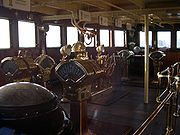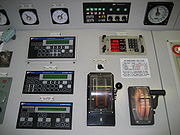
Engine order telegraph
Encyclopedia


Ship
Since the end of the age of sail a ship has been any large buoyant marine vessel. Ships are generally distinguished from boats based on size and cargo or passenger capacity. Ships are used on lakes, seas, and rivers for a variety of activities, such as the transport of people or goods, fishing,...
(or submarine
Submarine
A submarine is a watercraft capable of independent operation below the surface of the water. It differs from a submersible, which has more limited underwater capability...
) for the pilot on the bridge
Bridge (ship)
The bridge of a ship is the room or platform from which the ship can be commanded. When a ship is underway the bridge is manned by an OOW aided usually by an AB acting as lookout...
to order engineers in the engine room
Engine room
On a ship, the engine room, or ER, commonly refers to the machinery spaces of a vessel. To increase the safety and damage survivability of a vessel, the machinery necessary for operations may be segregated into various spaces, the engine room is one of these spaces, and is generally the largest...
to power the vessel at a certain desired speed. In early vessels, from the 19th century until about 1950, the device usually consisted of a round dial about nine inches (~20 centimetres) in diameter with a knob at the center attached to one or more handles, and an indicator pointer on the face of the dial. Modern E.O.T.s on vessels which still use them use electronic light and sound signals.
Traditional E.O.T.s required a pilot wanting to change speed to "ring" the telegraph on the bridge, moving the handle to a different position on the dial. This would ring a bell in the engine room and move their pointer to the position on the dial selected by the bridge. The engineers hear the bell and move their handle to the same position to signal their acknowledgment of the order, and adjust the engine speed accordingly. Such an order is called a "bell," for example the order for a ship's maximum speed, flank speed
Flank speed
Flank speed is a nautical term referring to a ship's true maximum speed, beyond the speed that can be reached by traveling at full speed. Usually, flank speed is reserved for situations in which a ship finds itself in imminent danger, such as coming under attack by aircraft...
, is called a "flank bell."
For urgent orders requiring rapid acceleration, the handle is moved three times so that the engine room bell is rung three times. This is called a "cavitate bell" because the rapid acceleration of the ship's propeller will cause the water around it to cavitate
Cavitation
Cavitation is the formation and then immediate implosion of cavities in a liquidi.e. small liquid-free zones that are the consequence of forces acting upon the liquid...
, causing a lot of noise and wear on the propellers. Such noise is undesirable during conflicts because it can give away a vessel's position.
On most modern vessels the main control handle on the bridge acts as a direct throttle
Throttle
A throttle is the mechanism by which the flow of a fluid is managed by constriction or obstruction. An engine's power can be increased or decreased by the restriction of inlet gases , but usually decreased. The term throttle has come to refer, informally and incorrectly, to any mechanism by which...
with no intervening engine room personnel. As such, it is regarded under the rules of marine classification societies
Classification society
A classification society is a non-governmental organization that establishes and maintains technical standards for the construction and operation of ships and offshore structures...
as a remote control device rather than an EOT, though it is still often referred to by the traditional name. This is somewhat confusing, as the classification society rules for merchant ships still in fact require an EOT to be provided, to allow orders to be transmitted to the local control position in the engine room in the event that the remote control system should fail. The EOT is required to be electrically isolated from the remote control system. However, it may be mechanically linked to the main control handle, allowing telegraph orders to be given using the same user interface as for remote control orders.
Order transmission
Two telegraph units must be installed; one to be installed on the bridge and the other one in the engine room. Two alarms are required; one placed in the engine room and other on the bridge.The order is given by moving the handle to the desired position on the dial face. This sends an electrical signal to the EOT placed in the engine room whose pointer acquires a position according to the signal given from the bridge.
An audible alarm
Alarm
An alarm device or system of alarm devices gives an audible or visual alarm signal about a problem or condition.Alarm devices include:* burglar alarms, designed to warn of burglaries; this is often a silent alarm: the police or guards are warned without indication to the burglar, which increases...
sounds at both ends. Accordingly the watch keeping engineer acknowledges the order by moving the handle of the engine room EOT to the required position and takes necessary action. This sends an electrical signal the Bridge EOT unit the pointer acquires the respective position. The alarm stops ringing to acknowledge that the order has been carried out.
Typical dial positions
Many ships have the following dial indications:- Full Ahead
- Half Ahead
- Slow Ahead
- Dead Slow Ahead
- Stop
- Dead Slow Astern
- Slow Astern
- Half Astern
- Full Astern
External links
- http://www.tpub.com/content/administration/14067/css/14067_31.htm
- http://www.antiquesofthesea.com/telegraphs.html

